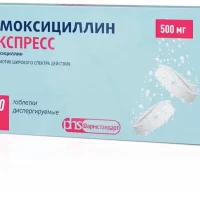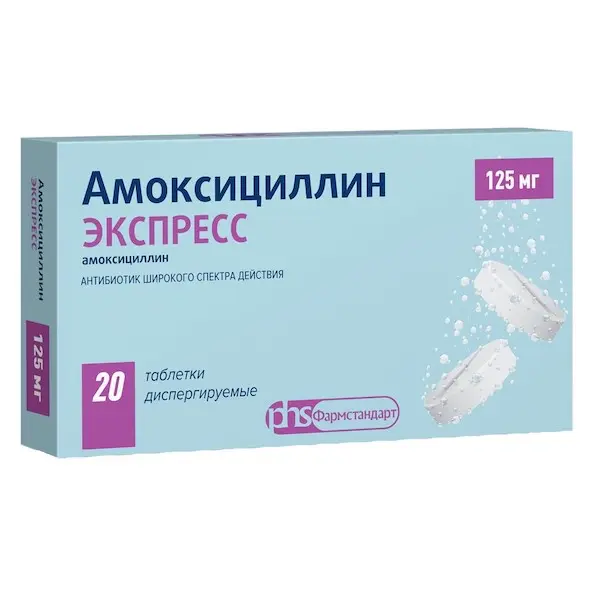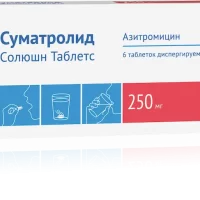Description
Sumatrolide Solution Pharmacodynamics
Azithromycin is a bacteriostatic broad-spectrum antibiotic of the macrolide-azalide group. It has a broad spectrum of antimicrobial action. Azithromycin mechanism of action is associated with inhibition of microbial cell protein synthesis. Binding to 508-subunit of ribosome, it inhibits peptide translocase at the translation stage and inhibits protein synthesis, slowing down the growth and reproduction of bacteria. At high concentrations it has a bactericidal effect.
It has activity against a number of Gram-positive, Gram-negative, anaerobic, intracellular and other microorganisms.
Microorganisms may be initially resistant to the action of the antibiotic or may become resistant to it.
Sensitivity scale of microorganisms to azithromycin (Minimum inhibitory concentration (MIC), mg/L):
Microorganisms MIC, mg/L
Sensitive Resistant
Staphylococcus < 1 >2
Streptococcus group A, B, C, G; <0.25 >0.5
Streptococcus pneumoniae < 0.25 >0.5
Haemophilus influenzae <0.12 > 4
Moraxella catarrhalis <0.5 >0.5
Neisseria gonorrhoeae <0.25 >0.5
Sensitive microorganisms in most cases:
1. Gram-positive aerobes
Staphylococcus aureus (methicillin-sensitive) Streptococcus pneumoniae (penicillin-sensitive) Streptococcus pyogenes
2. Gram-negative aerobes
Haemophilus influenzae
Haemophilus parainfluenzae Legionella pneumophila Moraxella catarrhalis Pasteurella multocida Neisseria gonorrhoeae 3.
Anaerobes
Clostridium perfringens Fusobacterium spp.
Prevotella spp.
Porphyromonas spp.
4. Other microorganisms
Chlamydia trachomatis
Chlamydia pneumonia Chlamydia psittaci Mycoplasma pneumonia Mycoplasma hominis Mycoplasma genitalium Borrelia burgdorferi
Microorganisms that can develop resistance to azithromycin Gram-positive aerobes
Streptococcus pneumoniae (penicillin-resistant).
Initially resistant microorganisms Gram-positive aerobes
Enterococcus faecal is
Staphylococcus spp. (methicillin-resistant staphylococci show a very high degree of resistance to macrolides).
Gram-positive bacteria that are resistant to erythromycin.
Anaerobes Bacteroides fragilis
Indications
Infectious and inflammatory diseases caused by microorganisms sensitive to azithromycin:
– Infections of the upper respiratory tract and ENT organs: pharyngitis, tonsillitis, sinusitis, otitis media;
– Lower respiratory tract infections: acute bronchitis, exacerbation of chronic bronchitis, pneumonia, including those caused by atypical pathogens;
– Skin and soft tissue infections: rye, impetigo, secondary infected dermatoses;
– initial stage of Lyme disease (borreliosis) – erythema migrans
– Infections of the urogenital tract (urethritis, cervicitis) caused by Chlamydia trachomatis
Contraindications
Hypersensitivity to azithromycin, erythromycin, other macrolides or ketolides or other drug components; severe hepatic impairment; phenylketonuria; children under 3 years of age; simultaneous use with ergotamine and dihydroergotamine.
Dosage and administration
- Orally, 1 hour before or 2 hours after meals.
- Dispersible tablet can be swallowed whole with water, or you can dissolve the dispersible tablet in at least 50 ml of water. The resulting suspension should be thoroughly mixed before intake.
- Adults and children over 12 years of age with body mass over 45 kg
- Infections of the upper and lower respiratory tract, ENT organs, skin and soft tissues:
- 500 mg once a day for 3 days (course dose of 1.5 g).
- Initial stage of Lyme disease (borreliosis) – erythema migrans: Once a day for 5 days: 1 day – 1.0 g, then from day 2 to day 5 – 500 mg (cumulative dose 3.0 g)
- In case of urogenital tract infections caused by Chlamydia trachomatis (urethritis, cervicitis):
- Uncomplicated urethritis/cervicitis – 1 g once.
- Children aged 3 to 12 years with body weight less than 45 kg
- Infections of the upper and lower respiratory tract, ENT organs, skin and soft tissues:
- at the rate of 10 mg/kg of body weight once a day for 3 days (course dose of 30 mg/kg).
- For convenient dosing it is recommended to use Table 1.
- Table 1 Dosage Calculation of Sumatrolide Solution Tablets for children with body weight less than 45 kg
- Body weight Azithromycin dose in mg
- 18-30 kg 2 tablets of 125 mg (250 mg azithromycin) or 1 tablet of 250 mg
- 31-44 kg 3 tablets of 125 mg (375 mg azithromycin) or 1.5 tablets of 250 mg
- At least 45 kgs, the doses recommended for adults are used
- In children under 3 years of age, the use of azithromycin in other dosage forms is recommended.
- In pharyngitis/tonsillitis caused by Streptococcus pyogenes, Sumatrolide Solution Tablets is used in a dose of 20 mg/kg/day for 3 days (a course dose of 60 mg/kg). The maximum daily dose is 500 mg.
- In Lyme disease (initial stage of Borreliosis) – erythema migrans: 20 mg/kg body weight once a day on the 1st day, then at a rate of 10 mg/kg once a day from the 2nd to 5th day.
- In patients with impaired renal function: no dose adjustment is required in patients with a GFR of 10-80 ml/min.
- In patients with liver dysfunction: no dose adjustment is required in patients with liver dysfunction of mild to moderate severity.
- Elderly patients: no dose adjustment is required. Caution should be exercised in elderly patients with persistent proarrhythmogenic factors due to high risk of arrhythmias, including “pirouette”-type arrhythmias.





